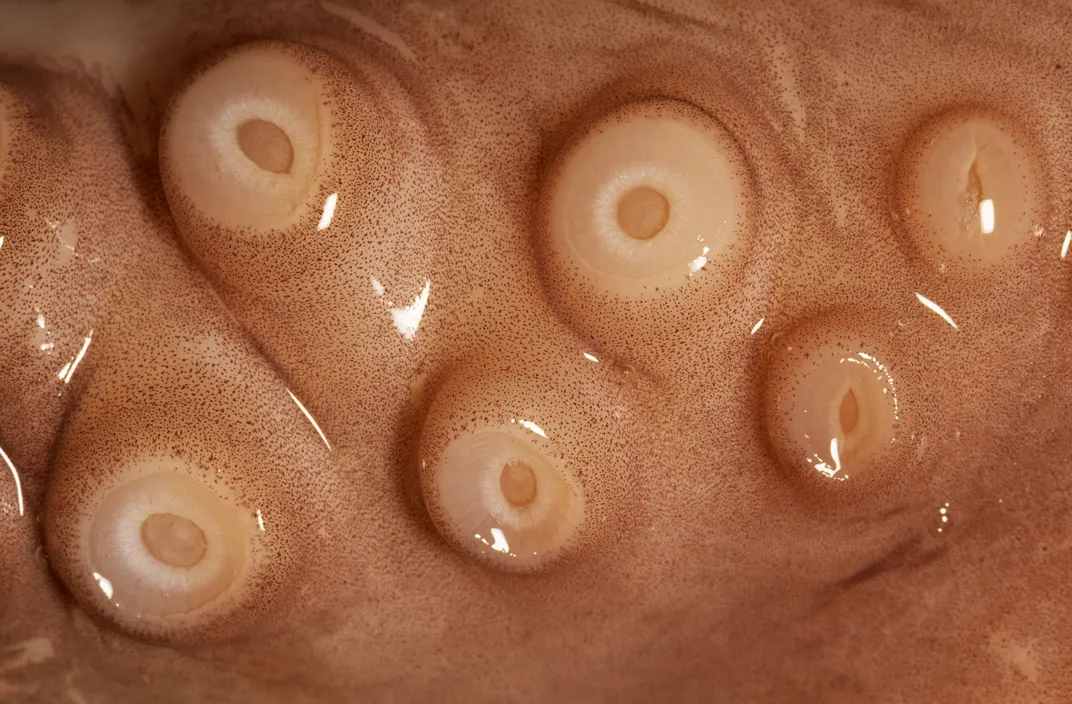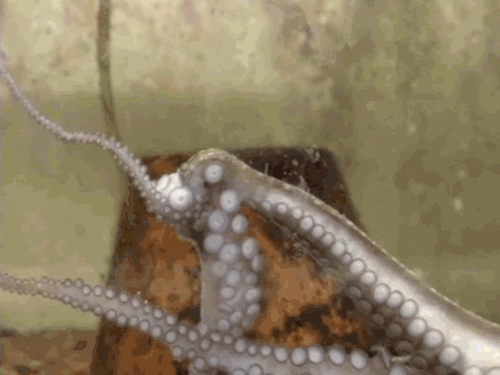Why Don’t Octopus Suckers Stick To Their Own Skin?
A chemical excreted by octopus skin tells their severed arms, “Don’t grab me or eat me!”
/https://tf-cmsv2-smithsonianmag-media.s3.amazonaws.com/filer/b2/f4/b2f49879-a1c4-456c-9729-7482581fe78c/42-25125512.jpg)
Imagine your arms stuck to almost everything they touched. Humans only have to worry about that in unfortunate incidents involving crazy glue. You'd think, however, that an octopus would suffer from over-attaching limbs: their eight tentacles are lined with hundreds of tactile suction cups that change shape and sense food. So, why don’t these arms stick together or end up in knots?
“It is surprising that no one even asked this question,” says Guy Levy, a researcher in the lab of octopus neurobiologist Benny Hochner at the Hebrew National University of Jerusalem. The problem of arms sticking together and getting tied in knots might seem silly from a human perspective. But, for an octopus, it’s an important evolutionary feat of movement control.
Levy, Hochner and their colleagues in the U. S. and Israel think they’ve figured out how octopuses do it. According to their study published today in Current Biology, octopus skin produces a chemical signal to override the tentacles’ suction-cup reflexes. Each chemical signal may also be unique to the octopus, which would prevent these sometimes-cannibalistic organisms from eating severed pieces of their own arms, too.
Scientists are interested in these alien-looking animals because similar to humans, they have big brains. These brains are comprised of 200 million neurons and capable of problem-solving and memorization (and even predicting important soccer games). “Really understanding the worldview of an octopus is critical to understanding what are the factors that go into making a big brain,” says Jennifer Basil, a biologist at CUNY’s Brooklyn College who was not affiliated with the study.
The octopus nervous system differs from ours in a key way: 300 million peripheral neurons extend through their tentacle arms and facilitate movement. Opposable thumbs are great, but these prehensile tentacles give octopuses freedom of movement that allow them to snatch up food, hide in small spaces, and steal scuba divers’ cameras.

“The octopus has complete control over its arms, but the control is distributed between the brain and arms, which are to some extent autonomic,” says Levy. So, when an octopus arm gets chopped off by accident or in a fight with a predator, it remains active for about an hour—instinctively grasping and holding anything it touches.
Because of their autonomy, the researchers saw amputated octopus arms as a way to try to answer questions about how these cannibalistic animals recognize their own attached (and unattached) arms from potential food.
The researchers began by humanely amputating an arm from common octopuses (Octopus vulgaris) in their lab. “This is not a traumatic event for the octopuses,” explains Levy, who carried out much of the lab work with his colleague Nir Nesher. “They lose arms in nature many times and continue to behave normally, and the arm grows back.”
The researchers put an octopus and different objects—amputated arms, skinned arms, fish, shrimp, and petri dishes partially covered in octopus skin—in a tank and watched what happened. Amputated arms never attached to themselves or grasped the arms of the live octopus in the tank, instead avoiding its former neighboring suckers.
The severed arms, however, did latch on to skinned octopus arms and the plastic part of petri dishes. The researchers measured the force applied to each object and found that the arms never applied grasping force to skin. So whatever signal prevented sucker attachment reflexes, it had to be coming from the skin.

Octopus skin is incredibly complex; it’s comprised of color-changing cells called chromatophores, along with chemical signaling networks, and nerve cells. To test whether a chemical signal might be at play, they smeared extracted octopus skin secretions and fish skin secretions on different petri dishes, and put them in the octopus’ tanks with the severed arms.
The forces applied by the severed arms to petri dishes with octopus slime were 10 times less than a regular petri dish and 20 times less than a petri dish with fish slime. Clearly, some sort of skin chemical conveyed the message, “Tentacles off!”
Chemical signals are widespread in biology, but the researchers note that this is the first chemical signal that triggers a motor behavior that doesn’t come down the chain of command in the brain. This signal not only keeps the creature from tying itself in knots, but probably also keeps the animal from eating its own severed arms. In tank tests, live octopuses sometimes latched on to amputated arms, too, but they were more likely to grab an arm and handle it like food if it never belonged to them.
The chemical signals appear unique to the animal, but determining how unique each signal is and pinning down the chemical recipe requires further investigation. “This chemical recognition of self, particularly in an organism that has appendages that are so free-form, is integral to understanding how an animal like that operates because there’s no other animal like that,” Basil says.
Their unique body and peripheral nervous system have also grabbed the attention of biorobotics groups. A number of labs around the world are attempting to develop a soft-bodied robot based on an octopus for applications from medical equipment to helping move patients in elderly care facilities. In this case, the Israeli lab works with a European effort called STIFF-FLOP that’s developing a flexible robot arm based on the octopus tentacle to help with less invasive surgeries.
"A mechanism like the one we found here can be of great help to the engineers," says Levy. For example, one could program an octopus arm-like surgical tool to avoid obstacles by chemical recognition, or "if the manipulator has to crawl through the pipes of the intestines, it can be programmed to avoid manipulating the intestines walls," he suggests.
The possibilities seem infinite. Perhaps octopus robots might even explore the depths of our oceans some day…with tentacles that don’t stick together, of course.
Correction: A previous version of this article stated that the octopus peripheral nervous system contains 300 nerves instead of 300 neurons.
/https://tf-cmsv2-smithsonianmag-media.s3.amazonaws.com/accounts/headshot/Screen_Shot_2014-01-27_at_12.05.16_PM.png)
/https://tf-cmsv2-smithsonianmag-media.s3.amazonaws.com/accounts/headshot/Screen_Shot_2014-01-27_at_12.05.16_PM.png)